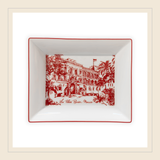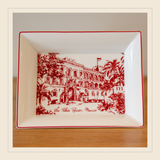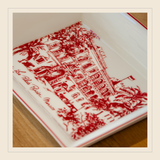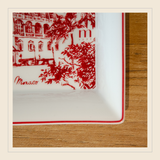A PASSIONATE ILLUSTRATOR
Since childhood, drawing has fueled her passion, shaping a creative universe marked by refinement, precision, and love for fine materials and objects. Her precise stroke, innate talent for sketching, and delicate paintings transport us to the heart of Monaco’s most iconic monuments.
What makes her unique is her ability to merge traditional brushwork with the technical mastery of a stylus on a digital tablet, thus combining tradition and modernity. Collaborating with the most prestigious luxury houses, she enthusiastically and spontaneously lent her art to Maison Monoïkos 1297, enriching its creations with a singular and elegant touch.
A NOTE OF HISTORY
The Prince’s Palace
Dating back to 1191, the Prince’s Palace of Monaco was originally built as a Genoese fortress to defend the region. Over the centuries, it became the official residence of the Princes of Monaco. Located on the Rock, this symbol of Monaco’s history and sovereignty is a remarkable architectural monument, with ceremonial rooms of exceptional splendor.
The Oceanographic Museum
Founded in 1910 by Prince Albert I, a pioneer in oceanography, the Oceanographic Museum of Monaco is a true temple dedicated to marine wonders. This majestic cliffside building hosts fascinating exhibitions and houses a famous aquarium showcasing the richness of marine ecosystems.
Monaco Cathedral
Built in 1875, Monaco Cathedral, also called Cathedral of Our Lady Immaculate, is the resting place of several members of the princely family, including Prince Rainier III and Princess Grace. In Roman Byzantine style, it is the setting for many of the Principality’s religious celebrations.
Saint Devota Church
Dedicated to the patron saint of Monaco, Saint Devota Church is a place of devotion deeply rooted in Monegasque tradition. Nestled in a small valley near the port, this modest church is the setting of one of the Principality’s oldest traditions: every year, on January 27, a boat is symbolically burned in honor of Saint Devota.
The Monte Carlo Casino
A true jewel of Belle Époque architecture, the Monte Carlo Casino is one of Monaco’s most iconic landmarks. Inaugurated in 1863, it attracts gaming and elegance enthusiasts from around the world, embodying the refined and luxurious art of living of the Principality.
The Carob Tree of Monaco
The carob tree, located on the Rock of Monaco, is an emblematic tree that is part of the natural heritage of the Principality. Symbolizing longevity and resilience, this century old tree is a living witness to Monegasque history and to its strong bond with nature.
The Exotic Garden
Perched on the heights of Monaco, the Exotic Garden is a true haven of peace, famous for its exceptional collection of succulents and cacti. This enchanting place, opened in 1933, offers spectacular panoramas over Monaco and the sea, while allowing the discovery of rare plant species from the four corners of the world.
Thus, the Principality, through its fascinating history and unique setting, continues to captivate the world, combining monarchical tradition with bold modernity.
AN EXCEPTIONAL PORCELAIN
All our porcelain pieces can be cleaned by hand. Use a soft sponge, warm water, and regular dish soap. Avoid using the abrasive side of the sponge, which could scratch or damage the decorated surface.
As these are art objects, handwashing is recommended. However, they can also be placed in the dishwasher, provided you choose a low temperature program, avoid excessive detergent, and ensure the pieces do not knock against each other.
In any case, if you do not wash them immediately, we recommend rinsing them with hot water.
THE PORCELAINE
Porcelain, a noble and delicate material, originated in China over a thousand years ago, where it was prized for its remarkable fineness, transparency and strength. Made from a mixture of kaolin, feldspar and quartz, porcelain requires meticulous craftsmanship and firing at very high temperatures, often exceeding 1,200°C, to achieve unrivalled hardness and shine.
Long reserved for emperors and royal courts, porcelain has travelled across centuries and continents. Captivating the world with its translucency, immaculate whiteness and perfectly smooth texture, it was introduced to Europe in the 18th century and became a symbol of luxury and refinement. Each piece, whether an art object, tableware or decoration, reflects a subtle alchemy between precision, technical mastery and refined aesthetics.
Today, porcelain remains a timeless treasure, appreciated for its purity and luminosity, and continues to appeal to lovers of elegance and authenticity. In the expert hands of our craftsmen, it is transformed into a living art, enhancing everyday life with discreet luxury and renewed creativity, proving that this exceptional material, despite its age, retains its unique character. At the crossroads of craftsmanship and industry, it embodies the perfect balance between tradition and innovation, offering creations that are both functional and elegant.
Our porcelain change trays are part of this approach, combining tradition and eco-responsibility to offer unique and sustainable pieces.


LES CONSEILS DE MONOÏKOS 1297
Toutes nos pièces en porcelaine peuvent être nettoyées à la main. Utilisez une éponge douce, de l’eau tiède et du liquide vaisselle classique. Attention toutefois à ne pas utiliser le côté abrasif de l’éponge qui peut rayer ou endommager la surface des décors.
Ce sont des objets d’art, il est donc recommandé de les laver à la main, néanmoins vous pouvez également les mettre au lave-vaisselle mais veillez à choisir un programme à basse température et à ne pas mettre trop de produit nettoyant. Veillez à ce que les pièces ne s’entrechoquent pas dans la machine.
Quoiqu’il en soit, si vous ne les nettoyez pas tout de suite, nous vous recommandons de les rincer à l’eau chaude.








